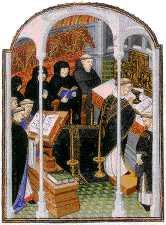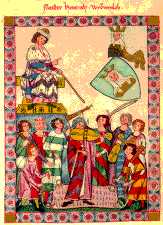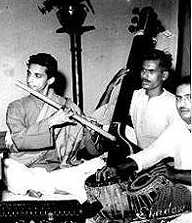Monophony
 PODCAST
PODCAST
A texture comprising a single line of musical tones.
[Example 1: plainchant, "Felix namque"]
Monophony is a texture comprising a single line of musical tones: that is, a single melody, or intonation, or cantillation.
It makes no difference whether there is one singer, or several, or many singers - so long as they all sing the same notes together, it is monophony.
[Example 2: song, "Foy porter"]
Monophony may be performed by singing, or by playing an instrument; or by combination of the two.
Middle Ages: plainchant

|
|
Fig.1 Monks chanting
|
In Western music, monophony is primarily a phenomenon of the Middle Ages. The monophonic music that has lasted longest, and has been the most influential is plainchant, otherwise known as plainsong, or Gregorian chant.
[Example 3: plainchant: "Puer natus est"]
This was the principal music of the Catholic Church from the 4th century through the end of the Middle Ages, and remained in use until late in the 20th century.
This chant, the words of which are "A boy is born, and a son is given to us" comes from the Christmas Day service. Its melody rises and falls in clear phrases, against a background of silence. That is, no other musical sound accompanies it - it is unaccompanied. Also, the melody is not sung in a regular rhythm: it is sung freely, without pulse or rhythmic pattern.

|
|
Fig. 2: Minnesingers
|
Middle Ages: troubadours
Plainchant was not the only instance of monophony in the Middle Ages, nor was monophony associated exclusively with the church. Other instances of monophony were the songs of the troubadours and trouveres of France in the 11th to 13th centuries, and the Minnesingers of Germany in the 12th to 14th centuries. And there was a large amount of monophonic medieval dance music. Most of this was performed in the royal and aristocratic courts.
[Example 4: troubadour song: "Ara no vei luzir"]
The troubadour here sings of his love of his lady. Unlike the plainchant example heard a moment ago, this song is sung in rhythm. It has a regular pulse, and the melody falls into distinct rhythmic patterns.
Thus we can see that monophony can be either rhythmic or non-rhythmic.
Percussion: medieval dances
[Example 5: dance: "La quinte estampie real"]
All the monophony of the Middle Ages comes down to us in the form manuscripts, in the form solely of melodies, with or without words. In the case of monophony for instruments, not even the instrument to be played is indicated. However, pictures of medieval music-making frequently include additional instruments, such as drums, clappers, and hand-cymbals. So modern performers often add percussion instruments.
This piece, a vigorous dance from the 14th century, is performed with a medieval instrument called a shawm, ![]() and with percussion on a pair of small drums. It is important to realize that the inclusion of percussion does not change the music's status as monophonic.
and with percussion on a pair of small drums. It is important to realize that the inclusion of percussion does not change the music's status as monophonic.
Drones: medieval dances
 [Example 6 medieval dance: Estampie "Danse real"]
[Example 6 medieval dance: Estampie "Danse real"]
Medieval pictures sometimes also show an instrument capable of playing just a single, sustained note or pair of notes - what we call a "drone," or , as in this example, a bagpipe with drone. Such a drone is never indicated in medieval manuscripts. It is added by modern performers. Again, it is important to realize that the addition of a drone does not change the status of the music as monophony. It does not change it into either polyphony, or homophony (the two other principal textures of Western music).
Some performers of troubadour songs have added drones to their performances of that music. The same is even true of some performances of plainchant - particularly of late plainchant, written in the 12th and 13th centuries.
[Example 7 Hildegard: "O Ecclesia"]
This performance of "O Ecclessia" by the 12th-century nun and mystic Hildegard of Bingen, for example, uses a soft drone comprising three notes, played on a string instrument.
Monophony: found in all musical traditions
Monophony is the prime musical texture the world over. It is found in all musical traditions, in all parts of the globe.
This American singer, recorded in the 1940s, is singing a ballad telling the gruesome story of Edward, who murdered his father.

|
|
Fig. 3: North Indian musicians: bansuri, tambura, tabla
|
Music of the Middle East, and of South Asia, frequently features drones, with or without percussion.
[Example 9: North Indian music]
In this example, from Northern India, the melody, which improvised, is played on a bamboo flute, while a drone is played on another string instrument, the tambura, and percussion is played by a pair of drums called tabla.
Summary:
- Monophony is one of the primary textures of music.
- It comprises a single line of musical tones - a melody, or intonation, or cantillation.
- It may be rhythmic or non-rhythmic.
- It may be sung, by one or more voices; or performed on one or more instruments, or in a combination of voice and instrument.
- To this single line may be added a drone or drones; and percussion.
- These additions do not alter the status of the music as monophonic.
- Monophony occurs in all musical traditions, throughout the world.
|
Monophony written by: Ian Bent
Recording & Mixing: Bradford Garton Narration: Thomas Payne Producers: Ian Bent, Maurice Matiz |
